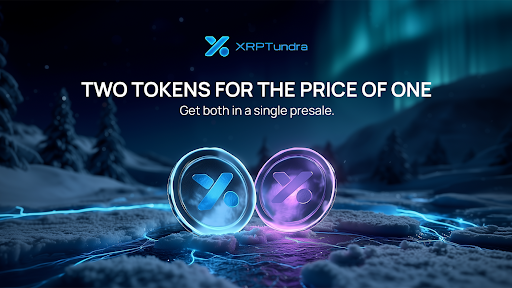XRP Staking Revolution: Tundra’s Cryo Vaults Offer 30% Frozen Returns

XRP holders have waited years for a reliable staking system. The XRP Ledger never included native staking, forcing investors to rely on off-chain programs or temporary liquidity farms. That gap is closing. XRP Tundra’s forthcoming Cryo Vaults introduce an audited staking layer built directly around verifiable contracts and fixed-yield logic — a structure designed to make returns measurable instead of speculative.
Each vault is engineered for transparency and compliance. Returns of up to 30 % APY are generated through fees collected inside Tundra’s on-chain liquidity pools and distributed according to lock duration, not arbitrary emission schedules. For the first time, XRP staking will exist inside an architecture that records, verifies, and limits every parameter before activation.
Why XRP Needed a Real Staking Layer
Despite XRP’s established use in payments, the network has lacked a built-in way to earn yield on holdings. Earlier attempts at external staking exposed users to custodial risk or wrapped-token mechanics with limited auditability. As institutional rules tighten, demand has shifted toward yield programs that are both transparent and provably non-custodial.
XRP Tundra approaches this by combining the XRP Ledger’s settlement finality with Solana’s execution throughput. Rather than building a new staking protocol from scratch, it uses the GlacierChain bridge — now in development — to route staking logic through Solana while anchoring balances on XRPL.
As a result, a model where users get rewards on-chain ensures that every transaction can be seen and scrutinized.
Inside the Cryo Vault System
Cryo Vaults function as controlled staking containers. Users lock their XRP or TUNDRA-S tokens for preset terms of 7, 30, 60, or 90 days. Those picking the shorter staking period will get the perk of flexibility. Picking the longer ones, however, offers a higher yield. The top-tier 90-day vault delivers up to 30% APY, while lower tiers scale proportionally.
Revenue for these rewards originates from transaction fees gathered through Meteora’s DAMM V2, the same liquidity framework that stabilizes TUNDRA-S trading. Because fees rise during market volatility, vault participants benefit from periods of heavy activity rather than suffering from it. Once a staking term ends, both principal and rewards are released automatically to the user’s wallet. No manual claims, no external farming contracts, and no off-ledger exposure.
Cryo Vaults also introduces an optional auto-relock feature that compounds returns while maintaining full visibility on XRPL. It’s staking without intermediaries — a design built to withstand compliance audits as much as market stress.
TUNDRA-S and TUNDRA-X: Yield Meets Governance
The staking process uses both of Tundra’s native assets. TUNDRA-S, operating on Solana, provides the liquidity and reward engine. TUNDRA-X is another token, which is hosted on the XRP Ledger, and its purpose is to power the project’s governance model and protocol reserves.
This offers a unique way of division of labor. Essentially, users get in terms of TUNDRA-S when they stake. However, if they want to weigh in on policy decisions, they can vote through TUNDRA-X. This is a deliberate approach to separate two tokens so that market volatility does not harm the governance model.
It is a unique approach that leads to a framework where both key assets have clear functionalities and can be audited, if need be, by proper parties.
XRP Tundra has Already Gotten its Contracts Audited
In the spirit of transparency, XRP Tundra has been very proactive in ensuring that all staking contracts and liquidity mechanics undergo multiple third-party reviews.
When it comes to Tundra’s contract logic, Cyberscope, Solidproof, and FreshCoins have been the auditors. And as far as the team KYC is concerned, it has been completed by Vital Block.
These audits have given assurance that Cryo Vaults follow a fixed set of rules and cannot be modified after launch. Lock terms, fee routing, and reward emission schedules are coded at launch and confirmed on public ledgers.
A recent walkthrough by Crypto Tech Gaming on YouTube examined the architecture in detail, emphasizing that each vault behaves like a financial instrument under transparent code. For staking platforms, that level of verification is uncommon.
Presale Entry Unlocks Early Cryo Vault Access
Staking is not yet active, but presale participants hold guaranteed early access once Cryo Vaults go live. TUNDRA-S is available on phase 6 remains at a discount price of $0.1 and gives usersa 14% bonus, and a free allocation of TUNDRA-X that is valued at $0.05.
To date, the project has attracted more than 11,600 contributors and has raised over $1.2 million. Joiners have also earned upwards of $10,000 through the Arctic Spinner bonus. Listing prices have already been set. They are $2.5 for TUNDRA-S and $1.25 for TUNDRA-X.
Because the presale has a fixed schedule and audited contracts, all investors are treated equally. And then Cryo Vaults open, early participants will be first in line to activate positions with verified on-chain rights.
Secure presale access today to unlock early staking rights when Cryo Vaults go live:
Website: https://www.xrptundra.com/
Medium: https://medium.com/@xrptundra
Telegram: https://t.me/xrptundra
X: https://x.com/Xrptundra
Contact: Tim Fénix — [email protected]
- New Crypto Coins Spotlight: Tundra’s Glacial Governance Model Breaks Ground
- Trump Cryptocurrency Policies Boost XRP Tundra’s Arctic Appeal
- How Little Pepe’s Community and Tokenomics Are Powering Its Explosive Growth
- FY Energy and the New Logic of Retail Mining
- Discussing XRP, BNB, and BTC Mining: How to Increase Passive Income In 2025
For PR & Sponsored Content Reach us :






